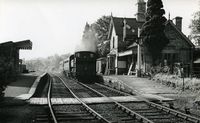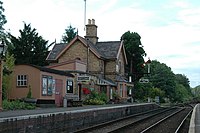
| Up (towards Kidderminster) | Down (towards Bridgnorth) |
|---|---|
| Highley (2 miles) via Country Park Halt |
Bridgnorth (4½ miles) via Eardington Halt (disused) |
Hampton Loade station is a minor country station located between Bridgnorth and Highley, located close to the River Severn. On opening, the station had only a single platform and a siding, with a second platform and signal box being added in 1880s.
Contents
The station
Hampton Loade station has two platforms and a signal box, allowing trains travelling in opposite directions to pass.
The station house is built of yellow brick. Unlike some of the other station houses including Highley and Arley, this was not upgraded by the extension of the waiting room and provision of an extra bedroom.
During the early years of SVR operation (early 1970s) Hampton Loade formed the southern terminus. Evidence of this remains in the form of the presence of the down starting signal on platform 2, which is normally only used for up trains.
During periods of lighter traffic, when Hampton Loade signal box is switched out, all trains use platform 1, adjacent to the station house. In late 2014 the railway announced that as the station house had become vacant, plans were under way for it to be converted into SVR volunteers' accommodation.[1] However, this is still subject to final agreements and costings between SVR Holdings PLC and Hampton Loade Station Fund, and as such should not be considered a 'done deal' just yet.[2]
The crossing loop at Hampton Loade is the shortest on the railway, only able to hold a loco and 8 full-length coaches.
Facilities
The station has a small kiosk serving snacks and hot and cold drinks. The Hampton Loade Station Fund Shop and the Barry Railway Carriage Trust sales van are both situated in the bay platform. There is a small picnic area next to the station.
Although the station has a very small car park, road access to the station is limited and SVR visitors are advised not to travel to Hampton Loade station by car.
Hampton Loade history before preservation
Although the village was also historically known as Hampton's Loade[3], the station was called Hampton at opening, but within a month had adopted the name Hampton Loade which it has retained ever since[4].
Key dates in the history of Hampton Loade were:
- 1862: Hampton Loade station opened with the rest of the Severn Valley Line on 1 February, with a single platform on the west side of the line and a short siding opposite. There was no facility for crossing trains.
- 1882-1883: Approval was given for construction of the up platform and provision of the passing loop and an additional siding, controlled by a newly-installed signal box. The Board of Trade approved these works in June 1883[4].
- 1930s: Hampton Loade was the site of a GWR camping coach pre-World War 2[4].
- 1963: Through passenger services ceased on 9 September, with through freight services ending at the end of November.
Points of interest
Passenger Foot Ferry
The station and the nearby Unicorn Inn are actually situated in the hamlet of Hampton. The village of Hampton Loade is on the other bank of the river (Loade comes from the Saxon word 'lode' meaning ford). There is now no ford or bridge, but in modern times a passenger foot ferry operated in summer months. However, the ferry has not operated since 2013, and it is not currently known when it will return to operation (March 2015).
Paddock Garden Railway
The Paddock Garden Railway, a 32mm gauge model railway, is situated adjacent to the station. This may be open on Sundays and Bank Holidays.
Barry Railway Carriage 163
Hampton Loade is the base for Barry Railway Carriage Trust who are restoring Barry Railway Carriage 163.
Gallery
An ex-GWR diesel railcar on a Northbound service in October 1959 (Sellick Collection)
Ex-LMS 40126 arriving with a Southbound service in April 1960 (Sellick Collection)
See also
References
- ↑ SVR(H) notice board issue NBI-H-194 "October-December 2014 Round Up", published on SVRLive.
- ↑ Hampton Loade Station Fund Committee minutes of meeting 22/02/15 (not available online)
- ↑ Handbook to the Severn Valley Railway, by J. Randall 1863
- ↑ 4.0 4.1 4.2 Marshall (1989), p101




